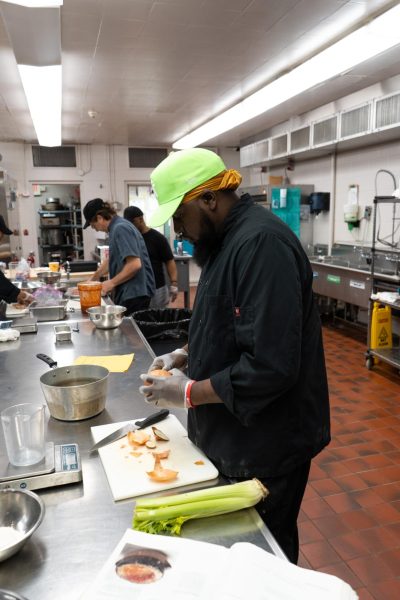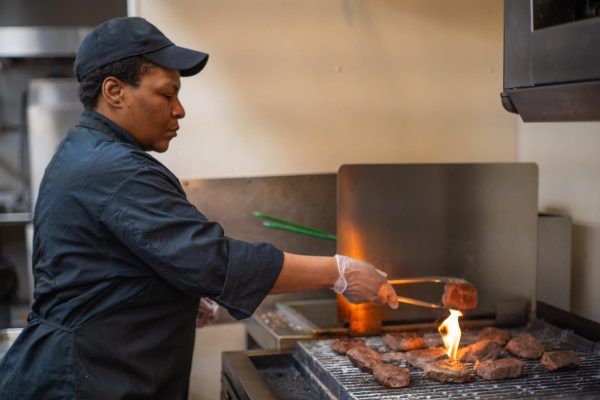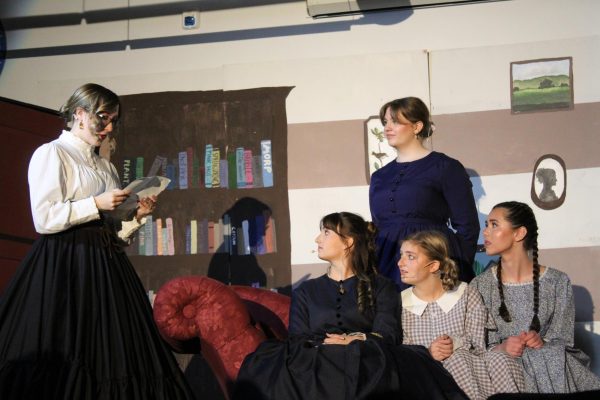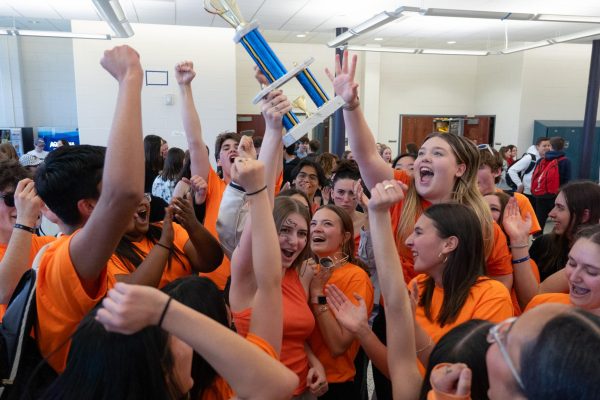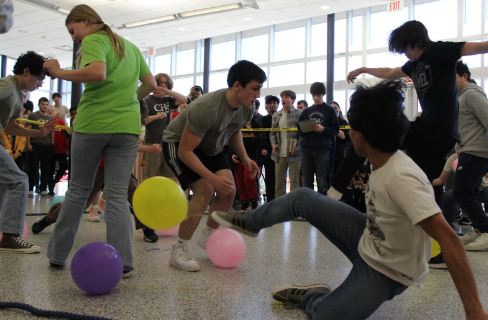Byron and Janice: Victory in the fight for educational opportunity
June 2, 2021
When Janice Cato Varlack arrived at George Wingate High School in Brooklyn, NY, only weeks after stepping off the plane from Jamaica, she expected it to be filled with what America promised to be for all immigrants: a place for opportunities. She expected that this school would be better than her previous one, Wolmer’s Girls School, but instead she was met with metal detectors, angry teachers, and chaos.
Twenty minutes away, Byron Varlack sat in his classroom at Brooklyn Technical High School thinking about the summer school it took for him to get into this magnet school. He did not have the preparation from his junior high or single mother to pass the standardized exam, but showing enough potential he was given the opportunity to take classes so he could attend the school.
The challenge both of them had faced was one that they had both seen so many around them take on: fighting for a good education in a black neighborhood.
According to the Brookings Institute, in low-income areas, students are faced with unskilled teachers, below-average curriculums, inadequate facilities, and limited extracurricular resources. Students do not have access to things like the arts, and these schools have higher teacher turnover rates with larger class sizes.
This is mainly attributed to the fact that “the wealthiest 10 percent of U.S. school districts spend nearly 10 times more than the poorest 10 percent.”
These obstacles in getting a good quality education disproportionately affect minority students, especially Black students, with a study done by the Joint Economic Committee finding that “Black children are three times as likely to live in poverty as White children.”
For Janice, she found a small reprieve from her disorderly high school in a program for future doctors, the only program her school offered, with eleven other students.
Besides the insufficient opportunities provided by school districts in black neighborhoods, social factors also play a major role in this struggle
Dr. Rajni Shankar-Brown, Jessie Ball duPont Chair of Social Justice Education at Stetson University and Executive Board Member of the National Coalition for the Homeless, explained how living in poverty affects students.
“We must actively support students living in poverty and experiencing homelessness, as data clearly demonstrates that students who experience housing and food insecurity are more likely to experience chronic absenteeism, less likely to graduate from high school, less likely to enroll in higher education, and are placed at significantly higher risk for physical and mental health issues,” Shankar-Brown said.
Black and Brown communities have faced these issues for decades, with many efforts made to fix the repercussions of poverty, but none of them being good enough.
The most notable effort was the War on Poverty waged by President Lyndon Johnson when he passed the Economic Opportunity Act of 1964. The act attempted to assist with education, unemployment, healthcare, and general welfare. At the time, many believed that the solution to the lives of the urban poor was coupling the social changes from the civil rights movement with the growth in the United States economy.
However, there were not many steps to actually institute this change, and decades later no real changes had been made.
Michael Tanner, a senior fellow of the Cato Institute, spoke on a panel at Columbia University about the War on Poverty about how the programs discouraged people from working and deterred people from marriage, which led to it being a catastrophe.
“The War on Poverty has failed to make those living in poverty independent or increase economic mobility among the poor and children,” Tanner said. “We may have made the lives of the poor less uncomfortable, but we have failed to truly lift people out of poverty.”
With the efforts in the past, helping these communities may seem hopeless, but in reality the solutions are the most basic ones. In order to combat poverty and create equal opportunities in low-income areas, the government must commit to spending money to help improve school districts and not handing out money, but building up the neighborhoods.
Despite these prevalent issues, Janice and Byron worked hard to escape the community around them. On the weekends, Janice went to Hunter College to study for her SAT, while Byron studied in his cramped apartment.
Their work led both of them to attending Stony Brook University, where they met. Janice majored in Biology and Byron studied both electrical engineering and computer programming. After graduation, Janice completed her training to become a physician at Weill Cornell Medical College in New York City.
Oftentimes, higher education is viewed as the key to becoming successful, and a lot of the time it can be.
According to the Joint Economic Committee, in 2019, the unemployment rate for Black Americans was 8.5%, while for White Americans it was 3.9%. However, in the same year, the unemployment rate for Black Americans with a bachelor’s degree shrunk to 3% and for White Americans it was 2%.
Although these statistics may seem encouraging, the reality is still bleak for Black workers. The Joint Economic Committee also found that “college-educated Black workers face a larger absolute income gap relative to Whites than those without a college education. Black workers with a bachelor’s degree and above earned $11,000 less than their White counterparts.”
Additionally, college educated workers face more in the workforce than only the income-gap, but discrimination as well. Because of this discrimination, Black households have less access to important things like tax-advantaged forms of saving.
In order to avoid becoming one of these statistics, Byron joined the National Society of Black Engineers at Stony Brook.
“We would prepare each other for interviews, we would talk about getting internships, and that was the only support system for us,” Byron said. “We used to go to these NSBE conferences where there would be job fairs where we would hand out our resumes. They were looking to fill their minority quotas.”
From one of these conferences Byron secured an internship doing engineering with the company Air Products & Chemicals and later was offered a position there. Being proactive in college helped him avoid the unemployment rates and discrimination that many Black students who are uneducated about things like summer internships face.
To stop discrimination and limit the consequences of it, the U.S. Equal Employment Opportunity Commission (EEOC) is supposed to enforce the title of the Civil Rights Act of 1964 that prohibits race discrimination in employment. However, in 2014, the EEOC found that “race discrimination remained the most frequent ground for discrimination… The issues most frequently alleged in these charges were discharge, terms and conditions of employment, and harassment.”
When Janice finished her residency at Weill Cornell she struggled to find a job, despite graduating from one of the top medical schools in the country.
“I definitely faced discrimination just going to interviews and never feeling accepted and always feeling marginalized and like I was looked at really weird,” Janice said. “But when I came to Freehold to start my family with Byron, there was a Black female pediatrician looking for another person to join her practice and we clicked, so I guess that was the right way for me to join the professional society. ”
Reco McCambry, President and CEO of the financial service Novae, shared his hope for the future of Black Americans like himself in the workforce.
“I have faced discrimination all my life at certain times. I have chosen not to let it cripple me and to devise a plan to maneuver my way around certain injustices to get the results I need for my family and the family of others,” McCambry said. “I do believe that my skin color puts me at a disadvantage at times in certain negotiations or opportunities but I continue to press on. I am optimistic that our world is changing and not everyone discriminates and will limit our opportunities because of the color of our skin.”
As years passed, Byron moved from job to job and eventually settled working as a Vice President in information technology for the investment management company BlackRock. Janice became a pediatrician at Rutgers Robert Wood Johnson Hospital, and the Assistant Dean of Students and Multicultural Affairs at Rutgers Robert Wood Johnson Medical School.
However, even when Black Americans are able to secure well paying jobs, the real gap between Black and White Americans and what contributes the most to the Black cycle of poverty is the wealth gap. Simply put, the generational wealth gap is the unequal distribution of assets like homes, cars, and savings passed down through generations in the United States.
“The persistence of wealth gaps in the United States reflect numerous social disparities including in the intergenerational transfer of wealth and this directly impacts students in regard to educational access, resources, and opportunities,” Shankar-Brown said.
In 2019, the Joint Economic Committee found that Black Americans have never had more than 5% of the nation’s wealth, while White Americans held 85% and that if this decline continues, by 2053 the median household wealth for Black Americans could reach zero.
The Joint Economic Committee also discovered that “the wealthiest Black children are nearly just as likely to remain in the top income quintile as they are to fall to the bottom as adults, whereas it is rare for rich White children to become impoverished as adults.”
Even when placed in school districts with amazing programs, after being able to graduate from college, and after finding a job, Black Americans still may end up in poverty because of the wealth gap.
The generational wealth gap exists because in the past Black Americans were excluded from specific programs that allowed White Americans to build up their wealth, because of redlining, and because homes in Black areas are undervalued.
Even when Black Americans did well despite these hurdles, there were still obstacles. In areas such as Black Wall Street in Tulsa, OK, which was a prosperous black business district, their wealth was destroyed through acts of domestic terrorism.
The destruction of the past currently affects Black Americans futures and the only option now is to start building intergenerational wealth to reverse the decline.
Byron and Janice’s solution to this problem is to teach their three daughters about the value of education and to help them financially.
“We are working really hard to ensure that whatever schools our girls go to that they don’t come out of college in debt and to give them some of our savings to invest and start their own lives,” Janice said.
Aside from the work Black parents can do, the government can also assist in reducing the disparity. In an article “How to build wealth” for the Brookings Institute, William G. Gale wrote suggestions on how to close the gap.
“Without cultural change, it is hard to see how public policies alone will be able to close the entire Black-white wealth gap,” Gale said. “Nevertheless, reforms could reduce the net worth differential significantly. Policy reform should aim to both redress injustices committed in the past and to provide equal opportunity for all today.”
Gale goes on to explain that this reform should start with ways to deal with America’s history of structural racism, reparations similar to the ones provided to ancestors of people who were in Japanese Internment Camps, policies to reduce the cost of college for Black Americans, and new homeownership policies.
However, Reco McCambry believes that there are easier ways to help just by starting discussions in the Black community.
“The key to Black Americans progressing is education,” McCambry said. “I’m not talking about general grade school or college. I’m talking about financial education, personal and professional growth and self development, self esteem coaching, knowledge of their rich history, and the exposure to the possibilities of what is really possible for us.”
Vivianna Varlack is the outgoing arts editor of The Inkblot and a member of the Class of 2021. She will be attending Stanford University.



